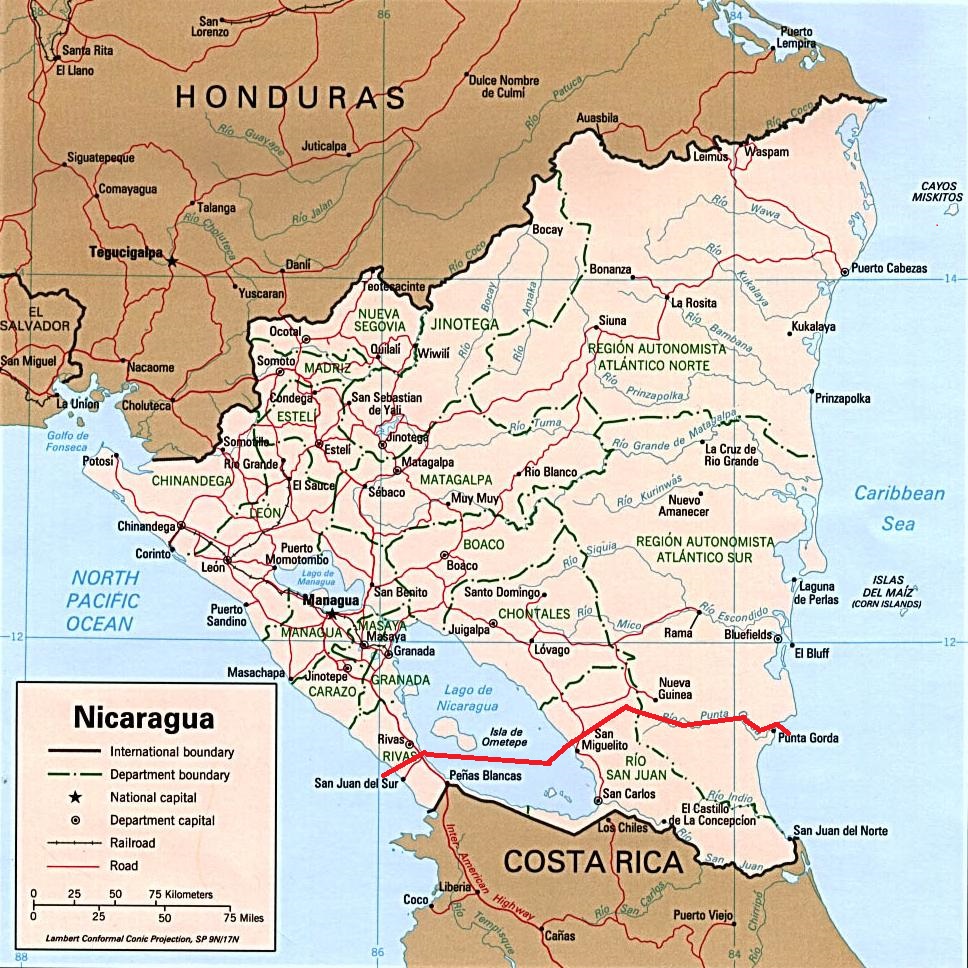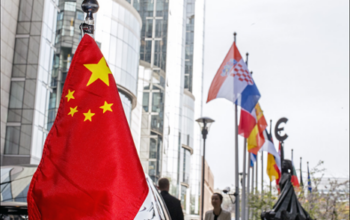On June 14, 2013, the Nicaraguan government passed a law enabling the construction of a big interoceanic canal across the country. In August next year, visions of an interoceanic canal through the Central American country between the Pacific and the Atlantic Ocean might become reality. The hope is that the forthcoming waterway will bring development and prosperity to Nicaragua that is one of the least developed in Latin America, according to the World Bank.
But the canal project does not only catalyse dreams of development. For some people living on the land intended to be used for the canal, the government’s plans constitute a threat to their homes and lifestyle. This is the case for the indigenous Rama people and the afro-descendant Creole people inhabiting Nicaragua’s Caribbean coast.

The red line shows the suggestion for the canal route through Nicaragua. The picture is a reconstruction based on the project plan from HKND Group. Original map by the U.S. Central Intelligence Agency
The Rama and Creole people traditionally live of fishing and small-scale agriculture in the jungle and to them their way of living is not only a tradition on the verge of vanishing into oblivion. It is also a way of co-existing with nature without harming one’s environment.
One year ago I visited a number of communities in the Rama and Creole Territory and several of the inhabitants emphasised the land’s importance for their lifestyle.
“Without our land, we are nothing”
According to Hilario McRae, a member of the local government in the Rama community of Indian River, the indigenous people are “nothing without Mother Earth”. He argues for the right of his people to their territory because the Ramas live from the forest.
“The reserve [the Indio-Maíz Reserve located in the Rama territory, ed.] is like a refrigerator to us,” he told me when I interviewed him last year about the arguments for protecting the Ramas’ land. “If we want to eat wild pig, we go hunting. If we want fish, we fish in the river. And without the forest, we will not have water. If you cut down the woods, the river will dry out. What carries the water is the roots of the trees. This is why we will not destroy the forest. This is why we call this Mother Earth – without our land and forests, we are nothing.”

Rama people on the Río Indio (Indian River), a part of their legally granted territory that is now threatened by the canal project. Photo: Ida Scharla Løjmand
And the threat of losing their land and culture to the international development project is not the only problem for the Ramas and Creoles. Civil society organisations, such as Amnesty International and the Nicaraguan NGO Fundación del Río, have criticised the Nicaraguan government for permitting the Chinese company HKND Group to construct the canal without the consent from the peoples who will lose their land to the project.
However, HKND Group states its commitment to sustainable development of the environment and Nicaraguan society in the company’s first CSR report. The corporation also claims to have consulted Ramas and Creoles back in 2014 to inform them about the canal’s impact on their land. According to HKND Group, the participants of these meetings were hopeful to see the canal constructed within short time.
The “century-old dream” of development
The first idea of constructing a waterway through Central America emerged already in the 19th century but as we know today, that route ended up going through Panama.
According to HKND Group, the interoceanic canal project is a “a century-old dream” coming true for Nicaragua. HKND Group also points out that global trends call for the construction of another canal. These are trends like increased global maritime trade, a rising global growth rate powered by new technology and emerging businesses, and shifting global trade patterns with more contribution from new markets in Africa and Latin America.
Moreover, HKND Group does not only consider the project having “profound global significance” but also being a way of bringing about economic growth and social development in Nicaragua and thus obtaining “win-win results”.

Rama house in the Indian River community. Photo: Ida Scharla Løjmand
Clash of interests
But the Rama way of living does not exactly harmonise with HKND Group’s visions about global trade and growth rates. And the case of the Nicaragua Canal reflects the challenge of balancing the interests of local communities with those of the rest of the country – and of the world.
This balance is not always easy to find. On one hand, the Ramas and Creoles and several human rights and environmental organisations are fighting to bring attention to the lack of respect to the indigenous and ethnic peoples’ land rights. On the other, a 2016 poll from the Nicaraguan public opinion research center M&R Consultores show that a majority of the Nicaraguans support the interoceanic canal.
Even inside the Rama and Creole Territory, some voices are protesting against the canal and some are condemning the opponents at the same time. Sometimes to an extent where it is hard to figure out who is arguing for what. Before my first visit in the Rama and Creole Territory last year, I was advised to not talk about the canal project for the sake of my own security.
In January 2016, two press releases from the Rama-Kriol Territorial Government (GTR-K) were issued – two completely different statements from what appeared to be the same messenger. The first states that Nicaraguan state officials tried to pressure the Ramas and Creoles to consent to the construction of the canal in the territory but denied them access to the full text of the supposed agreement. The other press release argues that free, prior and informed consent has been obtained from all nine communities of the Rama and Creole Territory “in accordance with the norms of GTR-K and respecting the traditions and customs of the indigenous Rama people and the afro-descendent Creoles.”
This message – signed and stamped by Hector Thomas McRea, the president of the Territorial Government – states that the previous press release is false and accuses canal opponents for abusing the membership of Territorial Government to publish “unauthorized communications”.
Whether the canal construction will actually begin is yet to be revealed in August next year.
Meanwhile, the dispute between advocates and opponents of the international mega-project will most likely go on. The question is how many voices will be overheard when globalisation arrives with promises of economic development.
By Ida Scharla Løjmand
Photo Credits:
Map: U.S. Central Intelligence Agency, public domain
Photo 1: Ida Scharla Løjmand, all rights reserved
Photo 2: Ida Scharla Løjmand, all rights reserved










